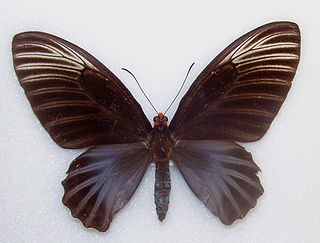
The earless monitor lizard is a semiaquatic, brown lizard native to the Southeast Asian island of Borneo. It is the only living species in the family Lanthanotidae and it is related to the true monitor lizards.
Stoliczkia khasiensis is a species of snake in the family Xenodermidae. It is endemic to Meghalaya, Northeast India. The type locality is Khasi Hills.
Dipterocarpus borneensis is a species of tree in the family Dipterocarpaceae. It is native to Borneo, Sumatra and Java.

The Borneo shark is a species of requiem shark, and part of the family Carcharhinidae. Extremely rare, it is known only from inshore waters around Mukah in northwestern Borneo, though it may once have been more widely distributed. A small, gray shark reaching 65 cm (26 in) in length, this species is the only member of its genus with a row of enlarged pores above the corners of its mouth. It has a slender body with a long, pointed snout and a low second dorsal fin placed posterior to the anal fin origin.

Atrophaneura nox, the Malayan batwing, is a papilionid butterfly found in Java, northern Borneo and Peninsular Malaysia.
Gastrophrynoides borneensis is a species of frog in the family Microhylidae. It is endemic to Borneo and is known from Sarawak and Sabah in Malaysia, but it is likely to be also found in adjacent Kalimantan (Indonesia). Common name Borneo narrowmouth toad has been coined for it.
Microhyla borneensis, also known as the Matang narrow-mouthed frog, is a species of microhylid frog found in the Matang Range in Sarawak, Borneo. It was once the smallest known frog from the Old World. Adult males of this species have a snout-vent length (SVL) of 10.6–12.8 mm (0.42–0.50 in), but adult males can reach a maximum of 13 mm (0.51 in),and adult females of this species have a snout-vent length of 16–19 mm (0.63–0.75 in), Tadpoles measure just 3 mm.

The ruddy cuckoo-dove is a species of bird in the family Columbidae. It is a medium-sized, reddish brown cuckoo-dove, found in Brunei, Indonesia, and Malaysia. It is rated as a species of least concern on the International Union for Conservation of Nature Red List of Endangered Species.

The white-crowned forktail is a species of forktail in the family Muscicapidae. Scientifically described in 1818, it has six subspecies, each occupying a different geographic range. The largest of the forktails, Enicurus leschenaulti, is between 25 and 28 centimetres long. It has a black throat and breast, black mantle, and largely black wings. The rump and lower back are white, and the bird has a prominent white crown, from which it gets its name. As with other forktails, the tail is long, deeply forked, and banded in black and white. A variety of whistling and clicking calls have been described. Slight morphological differences have been observed between subspecies.

The Bornean whistling thrush is a species of bird in the family Muscicapidae. It is found in Indonesia and Malaysia, where it is endemic to the island of Borneo. Its natural habitat is subtropical or tropical moist montane forests.

The Bornean horseshoe bat is a species of bat in the family Rhinolophidae. It is found in Brunei, Cambodia, Indonesia, Laos, Malaysia, and Vietnam.
Horsfieldia borneensis is a species of plant in the family Myristicaceae. It is a tree endemic to Borneo.

Upuna is a monotypic genus of plants containing the single species Upuna borneensis. The genus name Upana is derived from its Iban name Upan. The species name borneensis refers to its distribution, being found only in Borneo. It is a heavy hardwood similar to Vatica. While Upuna borneensis occurs in protected areas, it is threatened by logging, expansion of palm oil plantations and increasing frequency of fires.
Zollingeria borneensis is a species of plant in the family Sapindaceae. It is endemic to Borneo, and is threatened by habitat loss.

Craspedocephalus borneensis, commonly known as the Bornean pit viper, is a venomous pit viper species endemic to the island of Borneo. No subspecies are currently recognized.

Agathis borneensis, also known as Borneo kauri, is a species of conifer in the family Araucariaceae.
Musa borneensis is a species of wild banana, native to the island of Borneo, in the Malaysian states of Sabah and Sarawak. It is placed in section Callimusa, having a diploid chromosome number of 2n = 20.
Isonandra borneensis is a tree in the family Sapotaceae.
Madhuca borneensis is a plant in the family Sapotaceae.
Vatica borneensis is a tree in the family Dipterocarpaceae, native to Borneo.











